“People have been watching the first lady and what she wears since Martha Washington,” says Lisa Kathleen Graddy, curator of American political history, reform movements, and women’s political history at the Smithsonian’s National Museum of American History. For over a hundred years, the institution has worked to conserve and restore fashions worn by the first ladies. The National Museum of American History has long lured museum-goers with its display of inaugural gowns since the galleries were set up in 1912.
“People have always had an opinion about [their clothes]. And that’s something we’ve tried to address in the exhibition. Why do we care what the first lady wears?” she says. “She is considered to be the first lady of American society. She’s going out and representing us across the country and around the world so people tend to feel that they have a right to have an opinion.” Since 1789, the fabric, construction, origin and symbolism behind the clothes worn by the wives of presidents on inauguration day have been read like a press release on their intentions for the 4 years ahead. When Caroline Lavinia Scott Harrison publicized her dress as being American-made, it bolstered her husband’s America-first policy. With her Euro-centric fashions, Jackie Kennedy signaled her plans to infuse the White House with high culture. And when Michelle Obama wore J.Crew gloves, she communicated that she was a first lady for the people.
A look back at many of the inauguration fashions from throughout history, below.
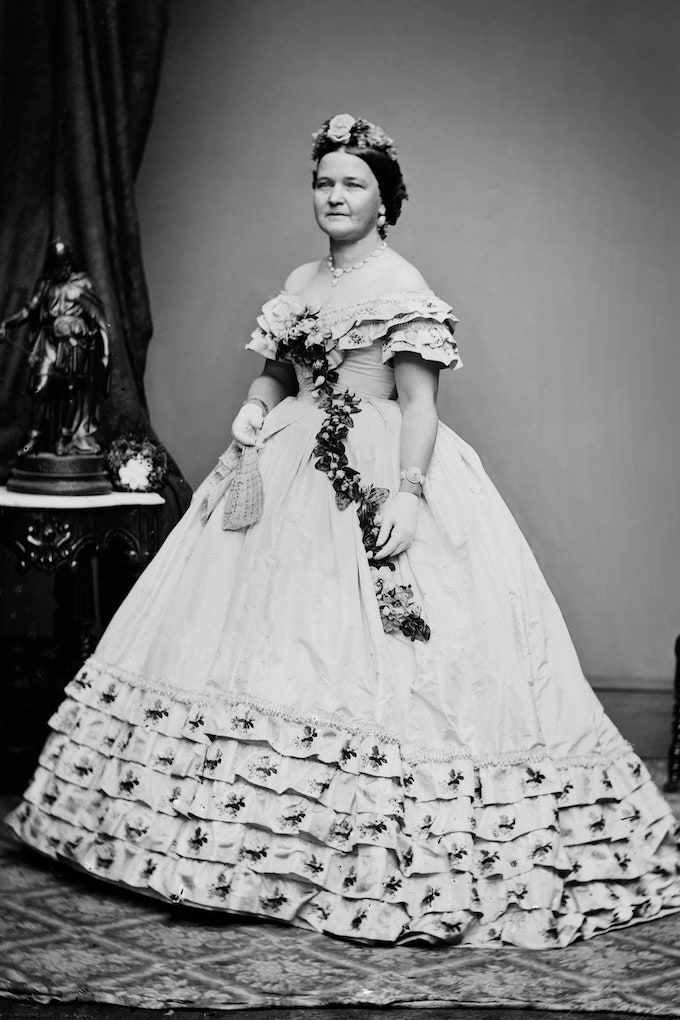
1 / 21
Mary Todd Lincoln
It’s not confirmed what, exactly, Mary Todd Lincoln wore to the inauguration ceremony celebrations, but it’s believed that she wore the same dress in this photo taken after the event. It features the highly fashionable crinoline skirt of the mid-19th century, which is festooned with ruffles and a florets pattern. She accessorized with fresh flowers, worn like garland sash across her bodice and in her hair. Mary, notably, frequently wore clothing by designer Elizabeth Keckley—a former slave—once she was in the White House. The designer met Mary the day of her husband’s inauguration and was immediately brought on to help fashion the first lady.

2 / 21
Julia Dent Grant
Julia Dent Grant, wife of President Ulysses S. Grant, is remembered as a first lady who understood the significance of her role. For her husband’s second inauguration in 1873, Julia wore a metallic ivory brocade dress trimmed with lace. For added modesty, she added a point-lace fichu around her shoulders, as was the fashion.

3 / 21
Caroline Lavinia Scott Harrison
First lady to President Benjamin Harrison, Caroline had his America-first economic policy in mind when commissioning her all-American inauguration dress. The gown was made in New York City by Ghormley, Robes et Manteaux, with silk produced domestically in New York by the Logan Silk Company. She took the symbolism to heart, enlisting Indiana artist Mary Williamson to design a brocaded silk pattern that paid tribute to her husband’s grandfather President William Henry Harrison with its burr oak tree leaves. It’s filled with trimmings—the skirt is bustled, pleated, and edged with beaded fringe, and the bodice is beaded, laced, and appliqued. The more-is-more aesthetic falls in line with the Victorian tastes for all things decorative.

4 / 21
Ida Saxton McKinley
The wife of William McKinley, Ida’s life was woefully filled with misfortune. She experienced the loss of several family members, including her two young daughters, and became diagnosed with chronic epilepsy that left her almost immobile. The press misunderstood her condition and scrutinized her abilities to serve as first lady, but Ida was resolute in proving herself capable. At her husband’s first inauguration in 1897, she wore an exquisite gown of pale gray brocade and added a lace fichu. Ida was a woman who appreciated handwork—on her grand tour, she witnessed the beauty of Belgian lace and became a lifelong collector of it.
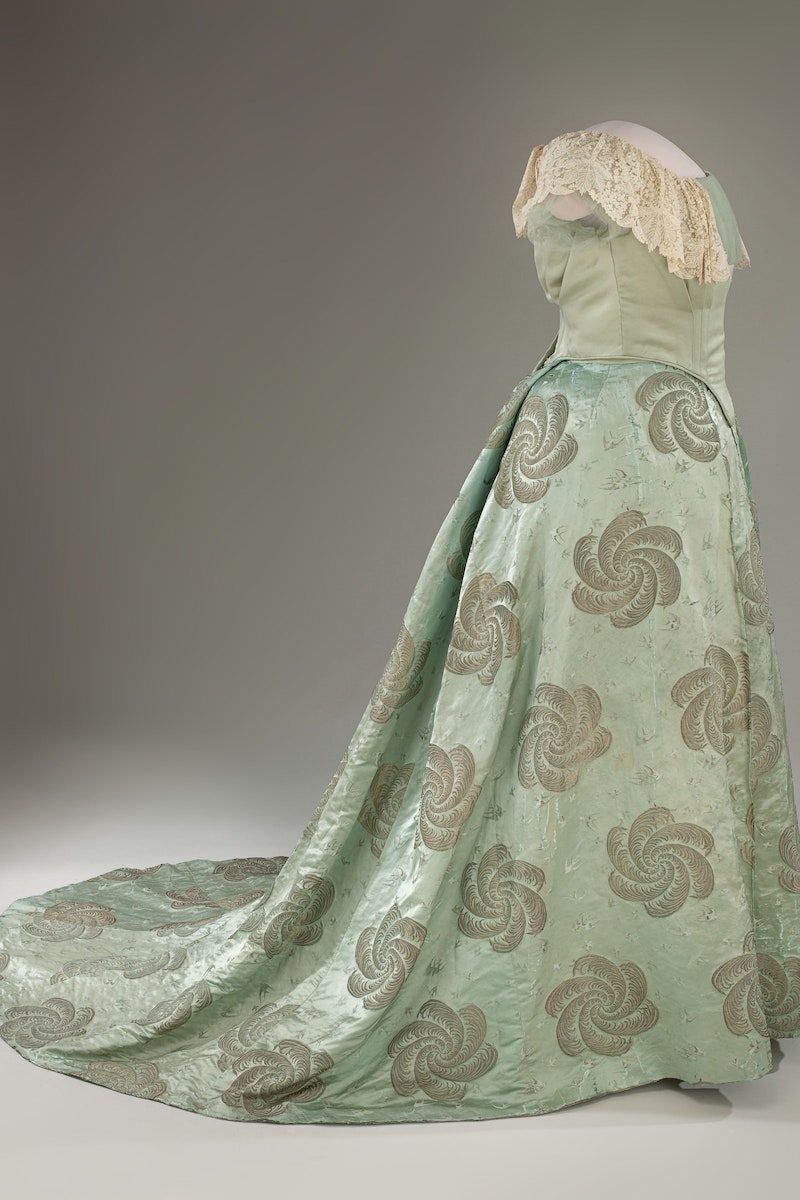
5 / 21
Edith Kermit Carow Roosevelt
This is a partial facsimile of the gown worn by Edith Roosevelt to her husband Theodore Roosevelt’s second inauguration as president in 1905. Just after Edith’s first ladyship ended, the Smithsonian Institute began collecting gowns belonging to wives of presidents. Edith unfortunately cut up most of her dresses (fabric was a luxury that was to be reworked into new dresses as styles changed). Eventually, the museum received the skirt belonging to her second inaugural gown and fashioned a bodice after photographs. Tiny soaring birds appear in the brocade, and, up close, the larger flower-like motifs reveal themselves to be feather plumes.

6 / 21
Helen Taft
We have Helen Taft to thank for the preservation and conservation of inaugural gowns throughout history. She was the first to donate her gown worn in 1909, an empire-waisted dress in ivory (since discolored to a buttery color) heavily beaded in sprays. In doing so, she set a precedent for all subsequent first ladies. She’s also pictured at the inaugural ceremony parade in a suit and wide-brimmed hat. Though her husband, William Howard Taft, would not be reelected, Helen’s impact was significant—she’s responsible for giving D.C. its cherry trees.
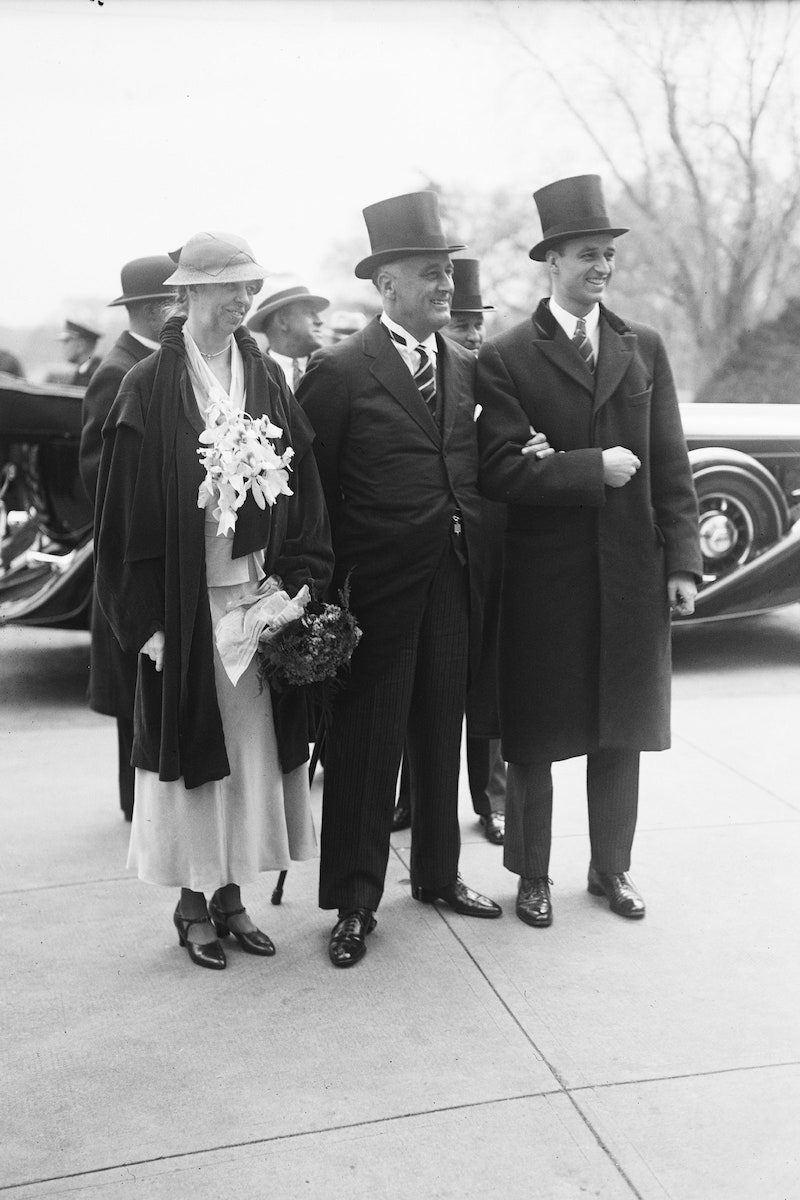
7 / 21
Eleanor Roosevelt
As American’s longest-running first lady, Eleanor Roosevelt held several inauguration ceremonies and balls. Prompted by the Second World War, her husband, Franklin D. Roosevelt was the only president to serve four terms. For her first inauguration in 1933, she wore a rhinestone and moonstone-embellished blue silk crepe dress designed by American fashion designer Sally Milgrim with detachable sleeves. At the inauguration ceremony, she wore a velvet dress and wrap, both in shades of blue and both by American designer Arnold Constable.
Technically, FDR canceled official balls for his second (in 1937) and third (in 1941) inaugurations because of the Great Depression and WWII, respectively, and hosted smaller events instead. Eleanor dressed both times in ivory-colored silk satin. For the fourth inauguration in 1945, she wore a long-sleeved, pink rayon gown with dart and lace details, also by Arnold Constable.

8 / 21
Bess Truman
Known as Bess, Elizabeth Truman was a First Lady who preferred to stay out of the presidential limelight, standing in stark contrast to her predecessor Eleanor Roosevelt. Harry S. Truman’s first inauguration was unplanned, taking place in 1945 soon after the death of FDR. For his second inauguration in 1949, the president and the first lady celebrated the affair fully with a series of elaborate and well-produced events. At one, she wore a dark-colored gown with a floral brooch and fur coat. Their daughter Margaret wore a diaphanous tulle gown.
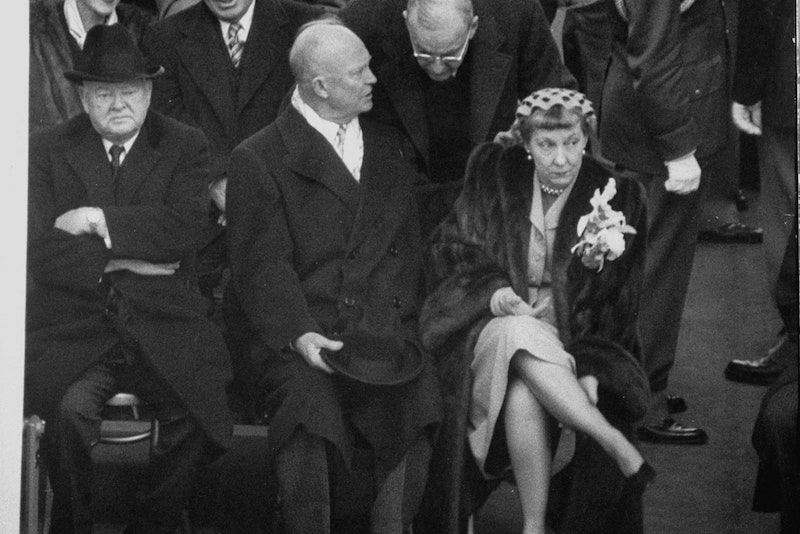
9 / 21
Mamie Eisenhower
Just before Jackie wore pink, so too did Mamie Eisenhower. At the first inauguration for her husband Dwight D. Eisenhower in 1953, she wore a peau de soie silk dress embroidered with more than 2,000 rhinestones. It was designed by New York-based designer Nettie Rosenstein (Judith Leiber made her bag and Delman made her shoes). At the ceremony, she wore a fur coat with a floral corsage.
Four years later, she wore yet another fur coat at the ceremony and for the ball, once again a dress by Nettie Rosenstein. This time, she selected an off-the-shoulder gown in a light yellow color, embroidered with pearls, crystal drops, and translucent topaz beadwork. She carried a bag featuring the letter “M” on one side and “1957” on the other. Mamie brought a light touch to the role of first lady, playing hostess with panache and embracing fashions all the while.
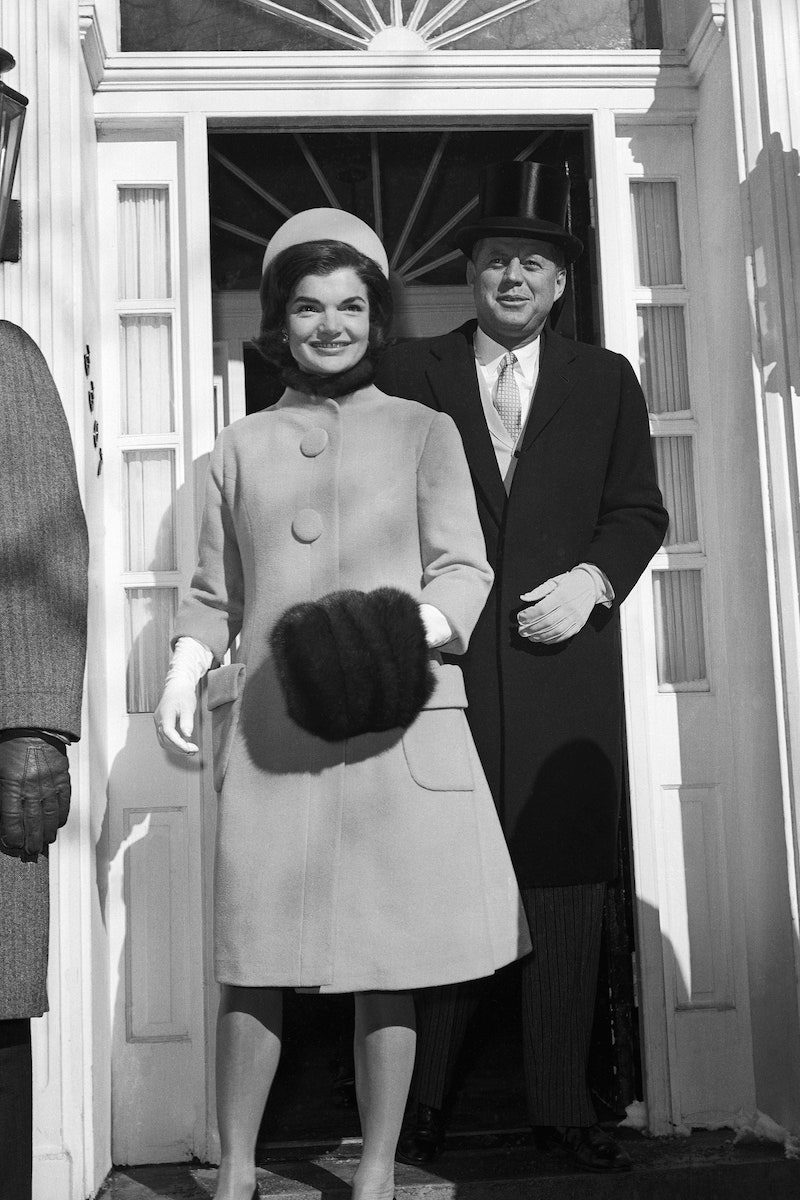
10 / 21
Jacqueline Kennedy
Jackie Kennedy’s time as first lady was relatively short but her impact was unlike anything the White House had seen. Never had the presidency seen such style, youth, and culture in its office. Shortly after the election of her husband John F. Kennedy, she announced that she hoped to position the White House as “a showcase of American art and history.” Oleg Cassini, costume and fashion designer to the stars, became Jackie’s unofficial Secretary of Style. For the swearing-in of JFK, Jackie wore a powder blue A-line dress and coat by Russian-born Cassini—the look featured over-sized buttons, a matching pillbox hat, and a muff for added warmth. For the gala, Jackie had a hand in designing her gown. She sent a sketch to Ethel Frankau of Bergdorf Custom Salon and the result was a columnar, off-white, sleeveless gown of silk chiffon with a chiffon overlay embellished with silver thread embroidery. It was just a couple of the many looks worn during her time as first lady that cemented her of the title few are really worthy of—fashion icon.

11 / 21
Claudia Taylor Lady Bird Johnson
Lady Bird Johnson (a nickname given to her in her infancy that had a lifelong endurance) became first lady in 1963 but there was little celebration. JFK had been assassinated and the world stood still in shock.
Two years later, after her husband Lyndon B. Johnson was elected in 1965, a much-publicized ceremony and ball took place. For the swearing-in event, she wore a red wool dress and matching hat. At the gala, a luxuriously yellow silk satin coat, trimmed with chocolaty sable topped a short-sleeved dress that only looked simple in its construction. Pleats and a clever V-bodice add architecture to the unadorned gown, designed by John Moore. In her true sensible fashion, Lady Bird opted for something she felt had a timeless appeal. She was aware her dress would be on display for years to come and made a choice she felt would age well. In her red wool ensemble, the moment marked the first time a first lady to hold the bible during the presidential oath of office, the duty was to symbolize her own part in the political position.

12 / 21
Pat Nixon
By the time Pat Nixon became first lady, she had already been second lady during the Eisenhower administration and was familiar with what the role required. In 1969 her husband Richard Nixon was sworn in and to the ceremony she wore a fuschia-colored, double-breasted coat by Jay Sarnoff Custom Couture, an American label. She paired it with a fur stole and hat. To the ball it would be a mimosa silk satin gown designed by Karen Stark for Harvery Berin. The dress was an elegant column of satin with a beaded waist in the same style as a cropped jacket worn with it. Her shoes by Herbert Levine were monogrammed at the right instep.
Four years later at Nixon’s second inauguration in 1973, she opted for yet another solid-colored coat, this time in a blue-green that was trimmed with a fur collar. At the gala, she wore a long-sleeved turquoise gown covered in crystal details by Adele Simpson. Pat’s fashions grew increasingly modest as the presidency progressed.

13 / 21
Betty Ford
Betty Ford became first lady suddenly in 1973 when her husband Gerald Ford was sworn in as president following the resignation of Richard Nixon. There were no formal inauguration festivities, but at the swearing-in ceremony she wore a very 1970s dress suit of powder blue. It’s skirt was ladylike and A-line and the matching jacket was edged in white piping. In some photos, she’s seen accessorized with a white floral corsage. Her time as first lady lasted only three years, but she’s remembered for her feminist activism and for raising awareness of Breast Cancer and alcohomism and susbtance abuse, both of which she experienced.

14 / 21
Rosalynn Carter
Rosalynn Carter was a one-term first lady who opted to minimize her role as hostess at the White House, instead focusing on diplomacy. Cited as her husband’s sounding board, she sat in on her husband’s cabinet meetings. Her no-nonsense approach carried over into her wardrobe. At the inaugural ball in 1977, she wore a dress the public had already seen before. The decision was not celebrated for it’s waste-lessness but rather it was deemed a lazy choice by the press, who knew she had worn the dress to Jimmy Carter’s inauguration as governor of Georgia in 1971. (For the second time around, Rosalynn did refresh the look with a new coat.)
The original dress, designed by Mary Matise for Jimmae, featured billowing chiffon sleeves in icy blue with a gold embroidered bodice. The sleeveless topcoat by New York designer Dominic Rompollo was trimmed in a gold textile that mimicked that on the dress’s bodice. Rompollo would also design the princess coat she wore to the swearing in ceremony—a blue‐green coat and dress with a stand‐up collar.

15 / 21
Nancy Reagan
A Hollywood figure before becoming first lady, Nancy Reagan understood what it meant to be in the public eye. Her appreciation and eye for fashion positioned her as a style maker, though she’s remembered mostly for her anti-drug programs. At Ronald Reagan’s first swearing-in ceremony in 1981, Nancy wore a coat and hat in a color dubbed “Reagan red.” It was designed by Adolfo. For the ball, she wore James Galanos—she was a repeated patron of the American couturier and cemented his status as an in-demand dressmaker. The first gown was a one-shoulder, heavily beaded (as was the Galanos way) dress with a lace overlay.
Four years later, at Ronald Reagan’s second swearing in ceremony, Nancy wore a collar-less electric-blue suit and hat, with gold chain jewelry and button earrings. Once again, she wore Adolfo for the ceremony and Galanos for the ball. For the second time around, the evening dress and jacket had a demure appeal. In white and silver colors, the look’s Art Deco-inspired beadwork reportedly took over 300 hours to hand-apply.
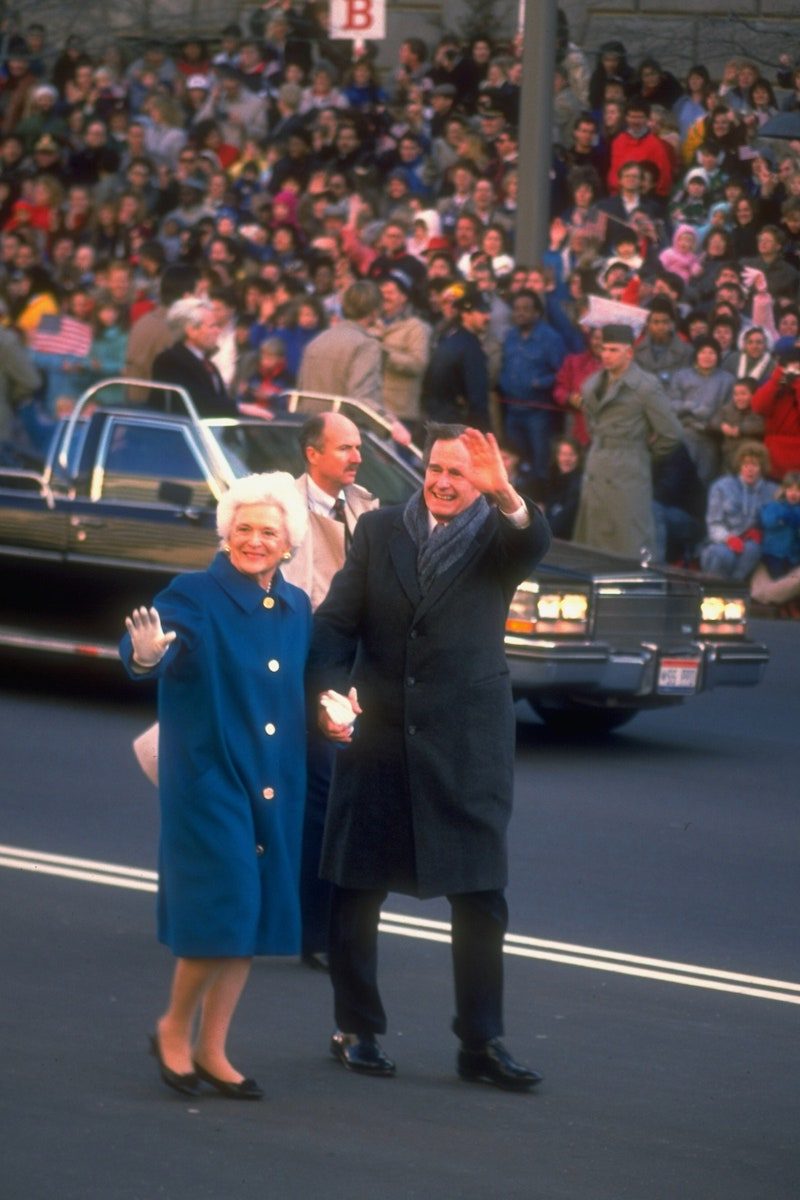
16 / 21
Barbara Bush
Coming after Nancy Regan, Barbara Bush’s personal style was less fashion forward and in line with her down-to-earth sensibilities. At the 1989 inauguration ceremony of George H. W. Bush, she wore a deep turquoise blue coat designed by Bill Blass and paired it with a multi-strand pearl necklace. That night, she wore a wonderful royal blue gown, by Arnold Scaasi, constructed in velvet at the bodice and sleeves with a draped satin skirt.
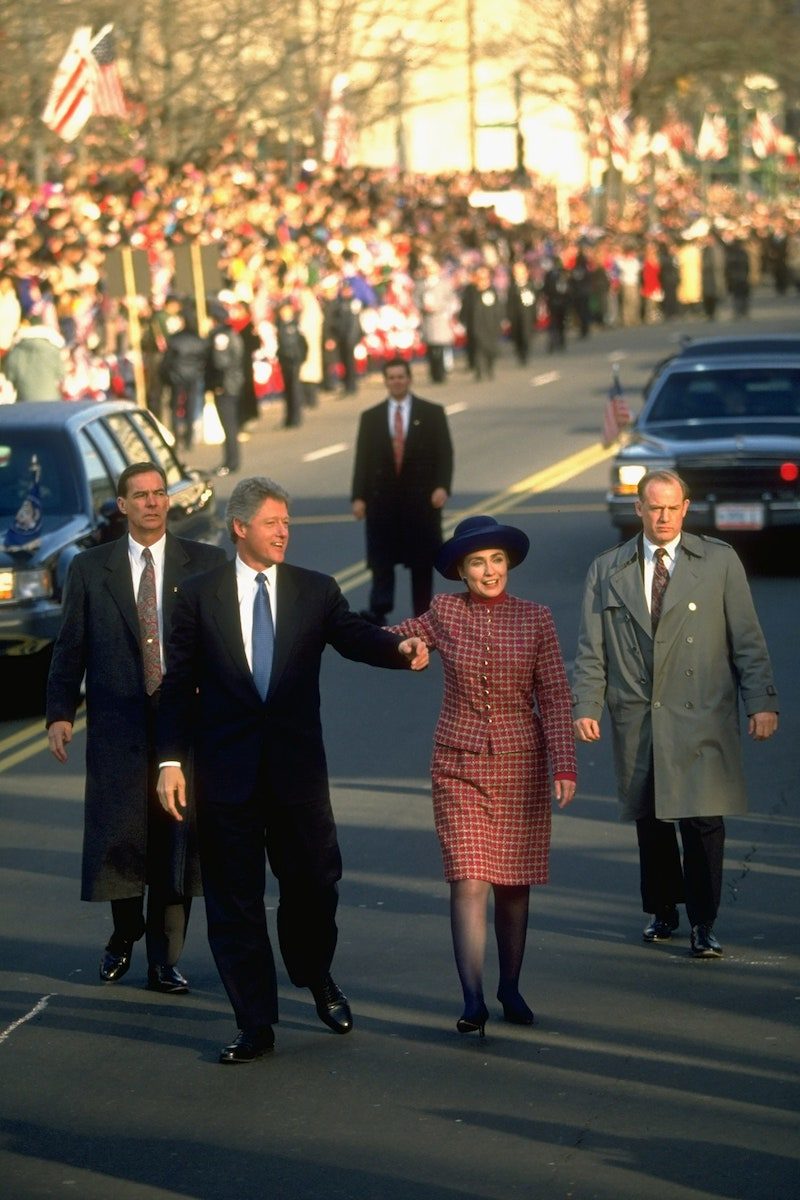
17 / 21
Hilary Clinton
Before her time in pantsuits as Secretary of State, Hillary Clinton more often wore dresses and skirts as first lady. At Bill Clinton’s swearing in ceremony in 1993, Hillary wore a checked pink suit by Arkansas designer Connie Fails. Hillary had commissioned several things by Fails to ready herself as first lady and topped the look with a cadet blue velour, off-the-face hat by Darcy Creech. At the inaugural ball, Hillary wore yet another Arkansas-based designer as a nod to her husband’s home state. The gown, designed by Sarah Phillips, was a slinky, violet-beaded, lace sheath dress with an iridescent, blue velvet silk, mousseline overskirt for added volume. Four years later, at Bill Clinton’s 1997 inauguration, Hillary looked to Oscar de la Renta to get dressed for inaugural events. At the swearing-in ceremony, Hillary wore his cheerful, coral-colored dress and coat set in wool melton. For the ball, she dazzled in a high-necked, long-sleeved embroidered tulle dress in ivory metallics.

18 / 21
Laura Welch Bush
Before she was first lady, Laura Bush was an educator and she took up literacy as one of her many initiatives. Bush brought a no-fuss flair to her time in office and the public responded to her reassuring presence.
In 2001, Laura looked to Dallas couturier Michael Faircloth, who is largely unknown outside of that city, to costume her for the inauguration. She wore a single-breasted, peacock blue coat and skirt to the day ceremony and later, a long-sleeved, crystal-embroidered Chantilly lace over silk-georgette gown. Four years later at George W. Bush’s second inauguration in 2005, Laura also sought out Oscar de la Renta. To the swearing-in ceremony, she wore an elegant winter white cashmere coat and dress. To the ball, she appeared in a V-neck, long sleeved dress embroidered with bugle beads and Austrian crystals in a soft blue to match the first lady’s eyes.

19 / 21
Michelle Obama
Come 2009, Michelle Obama, the first Black first lady, was a breath of fresh air. At Barack Obama’s 2009 swearing-in ceremony, Michelle exercised her knowing fashion eye in selecting a lemongrass-colored Isabel Toledo wool and lace dress and jacket with a pair of olive green, J. Crew gloves. At the ceremony, she was a vision in a white one-shouldered silk chiffon gown embellished with organza flowers with Swarovski crystal centers. The dress helped catapult its designer, Jason Wu, to fashion fame.
Four years later in 2013, Michelle appeared the modern woman in Thom Browne coat and dress set in a navy-silk, checkered-patterned fabric. The look was finished off with a matching belt embellished with metallic paillettes. The inaugural ball gown was once again designed by Jason Wu. This time, he chose a fiery red color for a silk chiffon halter dress that moved beautifully around the stage as Michelle and her husband danced.

20 / 21
Melania Trump
In 2017 Melanie Trump wore a sky-blue cashmere Ralph Lauren in what is said to be an homage to Jackie Kennedy and her blue Oleg Cassini. At the inaugural ball, she wore a vanilla silk crepe off-the-shoulder gown that was cinched with a claret ribbon in red around the waist designed by Hervé Pierre.

21 / 21
Dr. Jill Biden
At Joe Biden’s swearing in ceremony in 2021, Dr. Jill Biden wore a robin’s egg blue coat from the young, New York-based label Markarian, created by designer Alexandra O’Neill. The coat is custom-made and embroidered with Swarovski crystals for added sheen. Of course, the look comes with an accessory never before worn at an inaugural ceremony—a face mask. The covering is a reminder for future generations that, despite the celebrations of our new president, there is a pandemic still devastating the country.
This story was originally published on Vogue.com.





